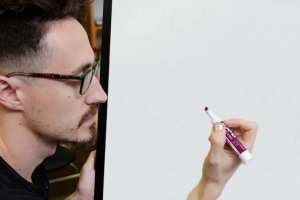The Power of Gold Nail Polish: Creating Brave Spaces

The idea to wear nail polish to school came to me one Monday in mid-September around 6:48 a.m. when I hit snooze for the second time and noticed I was still wearing it. I jumped out of bed and somewhere in between mentally making plans to skip breakfast and turning my bathroom upside down to find that large-but-always-lost bag of cotton balls, I stopped and asked myself, Why not just wear the nail polish to school?
When I was a fifth grader and throughout middle school, I discovered that I was different from most of the other boys and like many gender nonconforming preadolescents, I was bullied. Many of my peers called me gay like it was something inhumane and awful, but I speculated they had more of a problem with the way I expressed myself than with my sexuality. I felt alone. I felt like less. I started to hide because it became obvious that school was no longer a place for me to feel safe and be myself simultaneously.
As a fifth grade teacher at a progressive school in New York City, I know better than to feel alone or less or like I shouldn’t be myself, but these feelings have not washed away completely. After all, this is my first year teaching fifth grade so it makes sense to me that for the first time in awhile; I’m feeling like an insecure fifth grader again.
But what will they think?! I thought just before I finally eyed the cotton balls on the bottom shelf.
I managed to get all the gold off in time, but when I got to school I tossed around the idea of talking to my fifth graders about my experience that morning with my co-teacher, Brandi. I’m grateful she asked me “why?” not to discourage me, but to help me articulate why this might be important for these kids at this time. Here are the reasons I came up with:
1. For me: I can’t ignore the fact that my effectiveness as a teacher is a directly connected to keeping it real. I’m not suggesting that we tell our students all the details of our complex identities (I know some us live in states where we could get fired if we do), but that we find ways to share our true selves, even in the subtle shine of Bold Gold. Our stories pack power, especially when our students can relate, which brings me to my next reason…
2. For my students who experience something similar everyday: I wasn’t sure if they were out there, but I speculated they were, those who wanted to express their gender or any part of their identity in nonconforming ways and needed to be reminded that our classroom is a space where you can be brave by being yourself.
My co-teacher and I agreed that encouraging our students to communicate their various forms of self-expression was an important conversation to open at the beginning of the year and we brainstormed an activity to do just that. After a busy math workshop, we posed the questions, “What is one way that people see you and what is one way you want to be seen?” We reminded them that, “Even though you’ve known each other since Kindergarten, the ways we identify change and we have to be flexible in our thinking about each other.” And we begin by modeling. “I identify as a man but sometimes I like to wear nail polish, especially gold nail polish. Sometimes people think that is weird or wrong or just for girls, but I think it makes me… me.”
It was one of those moments when you could hear a pin drop. They leaned in and listened carefully. All twenty-five. Some of them reacted in shock, “Of course that doesn’t make you weird,” while others just starred back at me with a slightly more pronounced thinking face than I saw earlier as we analyzed decimals. And there was one who shouted, “Who made fun of you?! I want to talk to them!” An ally in the front row.
After our modeling, they all completed the activity at their seats, taking time to think it through in the quiet of our classroom, making a sketch to help us visualize if necessary. After fifteen minutes, we called them back to our meeting space and invited everyone to share. Many decided to keep their answers private, but some snatched up this opportunity to be heard.
“I want to be seen as smart even when I make mistakes.”
“I’m a good friend, but sometimes I have a major attitude.”
“I’m not sure if I’m pretty.”
“I’m a boy and I collect My Little Ponies. Have you heard of the Bronies?”
That night, I put on more polish, and the next day, I showed up proud of the gold on my nails. I had to walk the talk, to show them I could be myself and that they were capable of supporting me. After all, school is a place for that. Finally.
Our conversations about self-expression have continued. This was just the beginning… Teachers, how do you create a brave space for you and your students in your classroom? How do people see you and how do you want to be seen? It’s worth thinking about.
This piece was originally submitted to our community forums by a reader. Due to audience interest, we’ve preserved it. The opinions expressed here are the writer’s own.